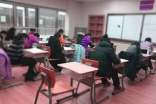2017托福阅读考试练习题
有的同学一提到考试就头疼,脑大,其实大家不用害怕,只要大家用心,多做题,就一定会有好的成绩。以下是小编为大家搜索整理的2017托福阅读考试练习题,希望能给大家带来帮助!更多精彩内容请及时关注我们应届毕业生考试网!

part A
being in a good mood decreases the brain's working memory, us researchers say.
“this explains why you might not be able to remember a phone number you get at a party when you are having a good time,” elizabeth martin, a doctoral student of psychology at the university of missouri, says in a statement. “this research is the first to show that positive mood can negatively impact working memory storage capacity.”
the researchers gauged study participants’ mood before and after showing them a video clip - some saw a bit of a stand-up comedy routine, while others saw a video on how to install flooring.
those who viewed the comedy routine were in significantly better moods after viewing the video, while the mood of flooring group had not changed. both groups were then given a memory test.
the study, published in the journal cognition and emotion, found those who watched the comedy routine performed significantly worse on the task.
美国研究人员称,好心情可能会降低大脑的工作记忆(属程序性记忆、短时记忆,是一种短暂时刻的知觉)能力。
“这就能解释为什么明明在派对上玩得很开心,却记不住从派对上得到的电话号码,”密苏里大学心理学博士伊丽莎白马丁在一份报告中指出。“该研究首次说明,积极情绪有损于工作记忆容量。”
研究人员在受试者观看视频片段前后对其情绪进行了测量。其中一部分受试者所看的.是轻松喜剧节目,另一些人所看的视频则关于如何铺地板。
那些看了喜剧的受试者观后情绪更佳,而“地板视频”受试者观前观后情绪并无波动。两组都接受了记忆测试。
此项刊登于《认知与情感》杂志的研究发现,观看了喜剧的受试者在记忆测试中表现明显差于另一组受试者。
part B
打字错误是谁都难以避免的,但是据最新研究得出的结论是,我们的手指能感应到打字正确与否。
whether you're a hunt-and-peck typist or a rachmaninoff of the keyboard, you will make mistakes. but it's not just your eyes catching typos when you see them on the screen. your hands know when you mess up too. that’s according to a study in the journal science. [gordon logan and matthew crump, "cognitive illusions of authorship reveal hierarchical error detection in skilled typists"]
researchers recruited expert typists—college students, of course—and showed them 600 five-letter words, one at a time. and they asked the students to type those words as quickly and accurately as possible. but sometimes, the researchers inserted typos in the word as it appeared on screen, when the students hadn’t made one. other times they automatically corrected typos the students did make.
and the students tended to believe the screen. so if a typo had been added, they figured they must have messed up. if a typo had been corrected they thought they typed it right. but the hands didn't fall for it. when the fingers slipped up, they paused a split second longer than usual before typing the next letter. but they didn't pause when fake typos appeared on-screen only. so we apparently have two discrete mechanisms guarding against typing errors, one visual, the other tactile. to fox quick brown fixes. to fix quick brown foxes.
以上就是小编对人托福阅读材料之手指感应的讲解,希望对同学们的`托福阅读考试有所帮助。考生在托福阅读备考的时候一定要事先了解一下类似的问题,这样能够给大家的托福阅读备考带来不小的帮助。大家一定要早准备!通过积累,一定会有所收获!
【托福阅读考试练习题】相关文章:
托福考试阅读练习题11-21
最新托福阅读考试练习题09-13
最新托福考试阅读精选练习题09-17
商业托福英语考试中级阅读练习题08-05
托福阅读理解练习题08-18
托福阅读考试经典题型10-23
2017年托福考试阅读理解练习题11-10
2017年新托福阅读理解考试练习题10-22
2017年托福阅读练习题10-09